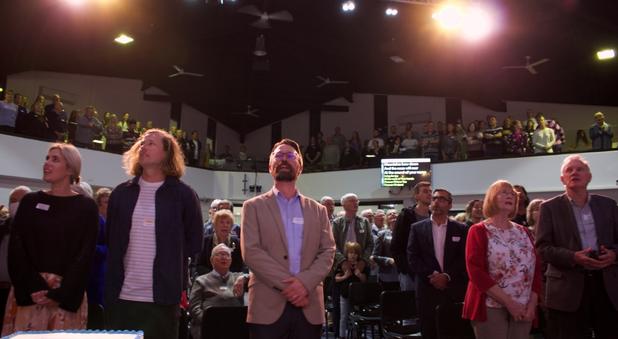Forty years ago last month, 43 adults and 25 children established Menai Anglican Church in the rumpus room of a house in Illawong, putting a sign up outside to let people know the home was also a church. Here they met, grew in faith and encouraged each other and the community as the population around them grew.
It might seem that 40 years is an unusual anniversary to highlight, but the parish’s church building, which opened four years later, was also the first to be completed under the 1980s Vision for Growth program.
The Rev Rob Barrie, who steered the Menai church through its first 28 years of life, recalled at a celebration event last month that “We had four different locations in four years”, adding that when the congregation “finally” moved into its own church, “boy, it was good to be here!”
To much laughter, Mr Barrie told the many hundreds squeezed into the church and hall for the celebration that, in 1984, the original 5.3-acre parcel of land in Barden Ridge cost only $330,000 – a tiny amount in today’s market.
The parish’s current rector, the Rev Andrew Barry, told Southern Cross that “in those days, the only things [anywhere near the church land] were a tip, a nuclear facility, a Christian school and a bunch of paddocks – and it’s completely surrounded by buildings now.
“The council wanted the church to buy land in the heart of Menai but it would have been a very small piece of land. Here, they were able to buy five acres and then subdivide it to sell a couple of houses off to help fund the church building.”
The money for the house in which the congregation initially met was provided by a member of Sutherland parish, Daisy Hill, and church members also gave sacrificially to fund the new building. In addition, Vision For Growth provided an interest-free loan, which helped to buy the land and build St Paul’s, Menai on the site.
Denise Gellett has been a member since day one and recalled how, in 1982, local parishes encouraged any members living in Menai or Bangor to consider becoming a part of the new venture.
She and her husband Jim moved from St John’s, Sutherland with their three boys – and because Mrs Gellett wanted to ensure her children and others would be well taken care of from the outset, she offered to run Sunday school in the house church.
“I taught primary children in the study downstairs, we had kindergarten and infants in the garage, and preschool upstairs in the loungeroom,” she said. “It kept growing week to week... [and] by the time our first anniversary came around, we had 75 adults and 63 kids!”
Mrs Gellett also did the church’s administration work in a voluntary capacity for the first year, then was employed half a day a week. She still works four half days each week in the office and only hung up her Sunday school teacher’s hat in 2012.
“We feel blessed,” she said simply, after the celebration service.
“We feel like God has given us so much.”
He certainly has. Menai Anglican now has a regular weekly attendance of 550-600 people, and has always been a church that looks outwards to its community and the world. Rob Barrie noted that, in the manner of Ephesians 4:16, every church member at the beginning of Menai’s ministry “was gifted in some way and had a role to play in helping us grow and build ourselves up in Christ”.
The church’s motto, “Menai for Christ”, has worked out in practice with people of all ages, and its focus on mission has both encouraged missionaries and sent them out.
Said Mr Barrie: “May God be praised and keep on blessing you in the years ahead”.
What was Vision for Growth?
The Vision for Growth initiative began in October 1984, under Archbishop Donald Robinson, to raise funds for land and churches in areas of the Diocese earmarked for rapid population growth.
Sound familiar?
What might also sound familiar are the 19 “strategic areas” the Diocese targeted. Among those on the list were Minchinbury, Quakers Hill, Cranebrook, Doonside, Bossley Park, Hoxton Park, St Clair, Eagle Vale, Appin – and, of course, Menai.
Over the life of Vision For Growth at least $7 million was raised for land and churches that now minister to well-established suburbs and towns across the Diocese.

















